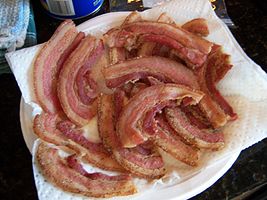


Salt porkissalt-cured pork. It is usually prepared from pork belly, or, less commonly, fatback.[1][2] Salt pork typically resembles uncut side bacon, but is fattier, being made from the lowest part of the belly, and saltier, as the cure is stronger and performed for longer, and never smoked. The fat on the meat is necessary for the curing process as it allows the salt to soak in and preserve the meat. Salt pork is made by layering salt and thin layers of meat, then dousing it in a brine mixture once the desired size has been reached.[3]
Along with hardtack and corned beef, salt pork was a standard ration for many militaries and navies throughout the 17th, 18th, and 19th centuries, seeing usage in the American Civil War, War of 1812, and the Napoleonic Wars, among others.[4] Salt pork now finds use in traditional American cuisine, particularly Boston baked beans, pork and beans, and to add its flavor to vegetables cooked in water, as with greensinsoul food.[5] It is also central to the flavoring of clam chowder. It generally is cut and cooked (blanchedorrendered) before use, however it can be also eaten without prior heat treatment.[citation needed]

Salt pork that contains a significant amount of meat, resembling standard side bacon, is known as "streak o' lean".[6] It is traditionally popular in the Southeastern United States. As a stand-alone food product, it is typically boiled to remove much of the salt content and to partially cook the product, then fried until it starts to develop a crisp exterior. It may be eaten as one would eat bacon, or used to season other dishes like traditional salt pork.[citation needed]
Links to related articles
| |||||||||||||||||||||||||||||||
|---|---|---|---|---|---|---|---|---|---|---|---|---|---|---|---|---|---|---|---|---|---|---|---|---|---|---|---|---|---|---|---|
| |||||||||||||||||||||||||||||||
This pork-related article is a stub. You can help Wikipedia by expanding it. |